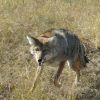|
|
Post by seldom on Aug 21, 2012 20:05:38 GMT -6
Weather turned cooler so I put out three test plots last Friday morning(A, B, C,) using an experimental lure and an established commercial bait and another lure fom a well known manufacturer We had a 1/4" of rain Saturday afternoon. Test holes are a 1" hole drilled vertically to a depth of 8". 1/2 tsp of lure is applied to dirt at bottom of hole. The test holes for the bait is identical to the lure holes and 1Tb of bait is applied to bottom of hole. Test holes were spaced 8 paces apart... lure-bait-lure....100yds.....lure-bait-lure. Test plots A and B were on and in the middle of an overgrown logging trail and only about 100 yds apart. I normally don't make them close together like that but I did. Three coyotes, one older and two pups used the trail together and traveled north to south and came in contact with both plots in a straight line and against the prevailing wind. Something possibly rolled( though I couldn't see any scratch marks of a roll due to the rain) or laid upon each of the same lured test holes before the rain but didn't dig. The coyotes showed little interest even though the lure hole wasn't filled in but did check that lure out in each of the two test holes. The other lure holes were ignored completely. Both bait holes were dug out as you see in the photos. They ignored the 1st lure, dug the bait hole, and checked the 2nd lure. This was repeated the same at both A & B plots. lure holes with tracks near  Same lure  Bait holes   Third test plot 8 miles away. Oops, had to check my notes--Both lures and bait were used in the same sequence and manner as test plots A & B. The lure that was ignored in plots A & B was driven over by a tractor but there was no evidence that it was worked whatsoever. Both the lure(checked out lure in plots A & B) hole and bait hole were double-dug out!!! Dug before the rain and dug out again Sunday night by both adults and pups. lure hole (hat is for size comparison)   Bait hole   Overview of test plot area(stall out). Lure dig-out is in forefront of photo and the Bait dig-out is hidden by blackberry canes but it"s only about 8 paces further into the sand blow.  Test plots A & B were on a travel way and test plot C was in a stall out location. |
|
|
|
Post by trappnman on Aug 23, 2012 7:55:17 GMT -6
I guess you have answered these questions!
do you think that if a coyote smells your lure (whether 2 blocks away, or at the set), he automatically walks over to it and sticks his nose into the hole?
do you think all lures are universal- or do you think certain lures and odors provide more intensity at the set?
thanks for the pics they sum up exactly the point we were talking about through much of these coyote discussions. and that is that the goal isn't to have a coyote aware of your lures(set) but to have a coyote be aware of them in a location where his innate behaviors allow him to to approach and work the set the highest % of te time.
the pics go right back to what I mentioned in snow earlier about coyotes walking right by your set, never hardly breaking stride, yet down the road that same coyote veers right towards an identical set and there he is-
|
|
|
|
Post by bogio on Aug 23, 2012 10:29:18 GMT -6
I guess you have answered these questions! do you think that if a coyote smells your lure (whether 2 blocks away, or at the set), he automatically walks over to it and sticks his nose into the hole?
do you think all lures are universal- or do you think certain lures and odors provide more intensity at the set?thanks for the pics they sum up exactly the point we were talking about through much of these coyote discussions. and that is that the goal isn't to have a coyote aware of your lures(set) but to have a coyote be aware of them in a location where his innate behaviors allow him to to approach and work the set the highest % of te time. the pics go right back to what I mentioned in snow earlier about coyotes walking right by your set, never hardly breaking stride, yet down the road that same coyote veers right towards an identical set and there he is- My thoughts exactly. The proof is in the pudding and Seldom served it up in toto. |
|
glen
Tenderfoot...

Posts: 9
|
Post by glen on Aug 27, 2012 18:05:13 GMT -6
Great post Seldom, one thing I can add is that I have done a lot of trapping in hot weather, 90+ degrees, and I can tell you that animals will react very differently to lures and urine when it is hot than when it is cold and at different times of the year.I think that correct lure usage is one of the most under discussed issues in trapping, but one of the most important
|
|
|
|
Post by trappincoyotes39 on Aug 27, 2012 18:28:19 GMT -6
Glen agree for sure.
|
|
|
|
Post by natedawg on Aug 29, 2012 17:11:45 GMT -6
Considering the bait was worked hard in all 3 test plots whereas the lure was not, wouldn't that make you lean towards using bait at the majority if not all of your sets? Minus a few scent posts mixed in possibly.
|
|
|
|
Post by seldom on Aug 29, 2012 17:42:31 GMT -6
Considering the bait was worked hard in all 3 test plots whereas the lure was not, wouldn't that make you lean towards using bait at the majority if not all of your sets? Minus a few scent posts mixed in possibly. Yes, it'd be pretty hard to ignore this particular bait!   |
|
|
|
Post by Stef on Aug 29, 2012 18:47:59 GMT -6
I know....lol.
|
|
|
|
Post by tripleex on Aug 29, 2012 21:10:16 GMT -6
Well what bait is it?
|
|
|
|
Post by seldom on Aug 30, 2012 4:59:11 GMT -6
I learned a hard lesson back in the 70's to never talk about my sets or talk about the scents I use at them. After all those years I can count on one hand the people who know what I do and how, strictly because of the intrinsic value to me. I've spent a hell of a lot of $$ over the years testing scents and finding that if I'd bought them and used them out-of-hand on my lines because somebody "who said it to the greatest magnitude" said to use them I'd have REALLY WASTED my time and $$!!!! So I don't give anything of that value away free for the asking! Folks have to spend their own $$ and put in their own time to learn what works and more importantly, what doesn't by comparison.
That being said I'm going to break my code of silence this one time. Thinking about the question and manufacturer's present circumstances overnight, I decided it would be remiss of me to not try and positively affect his ability to make a living manufacturing lures and baits. The bait was Stef's Champion and the lure was an experimental of his. The second lure that received no attention was from another very well known scent manufacturer.
On a similar side note:
Those who read the "Scent Attractant" study 1080 posted, there is one sentence in the study that incapulates the whole purpose and goal of my testing of scents. If you didn't read it, you missed out on something very important in my opinion!
|
|
|
|
Post by trappnman on Aug 30, 2012 8:17:46 GMT -6
I was going to reread the study, and I must have dreamed it. Guess I'll have to copy and paste everything from now on.
First reading left me puzzled and confused as to what conclusions were to be drawn. Several times I want to put that into a post, but couldn't put into words exactly what my concerns were.
One reason I tried to re access that study again, was to jot down the names of the two studies that contradicted the results in this study, vis a vis sex and season.
one thing that I did ponder- was was there any pattern beyond statistical irregularities in actions that would benefit trapping?
in other words, do all of these separate reactions matter, if a trap is there?
The study stated that a study on free ranging coyotes would be next- did that ever happen?
|
|
|
|
Post by bogio on Aug 31, 2012 15:00:26 GMT -6
First off....... what thought process leads someone to think,"You know, I think the vaginal secretions of a rhesus monkey might be attractive to coyotes. I going to test them!" Who does the collection work? Low man on the ladder?
This study among other things seems to indicate that the testing of attractants/baits in the summertime is an effort in futility in terms of proving effectiveness for winter/spring work. My own trapping has shown me that even the span of a month in the winter can show quite a difference in coyote receptiveness to particular attractants/baits.
Did this research lead to superior synthetics that out shined/replaced the commercially available biologically based attractors?
1080, what did testing on free rangers show?
|
|
|
|
Post by jim on Sept 1, 2012 3:22:13 GMT -6
When is an attractant a bait instead of a lure? I think of a bait as a chunk of meat or fish either fresh or tainted. When you measure it by the tablespoons I think it probably is more than a ground up piece of one meat or fish. If in a hole 8 inches deep it is just a lure to me. Does it half to be a solid instead of a liquid?
Jim
|
|
|
|
Post by seldom on Sept 1, 2012 5:52:42 GMT -6
When is an attractant a bait instead of a lure? I think of a bait as a chunk of meat or fish either fresh or tainted. When you measure it by the tablespoons I think it probably is more than a ground up piece of one meat or fish. If in a hole 8 inches deep it is just a lure to me. Does it half to be a solid instead of a liquid? Jim I figure a scent is a scent whether it's labeled by the manufacturer as a "bait" or "lure" regardless of the scent's base. The baits I've tested and use are meat "based"(cat, beaver, horse, etc.) whereas the lure I have no idea. For the purpose of comparitive testing I need a standard to follow that's the purpose of the TB, the 1/2tsp, the hole diameter, and the hole depth. It seems quite universal that bait manufacturers suggest using a TB but the lure amount appears to be controversial so I used 1/2tsp as a standard measure. To answer your question specifically Jim, probably not. Meat, such as fish could/can be ground and broken down to a semi-liquid state or to a liquid state, have additives mixed in and probably be called a "bait" because of it's meat base. Since I'm just a user and not a producer of scents anything beyond my needs is only guessing on my part though. |
|
























